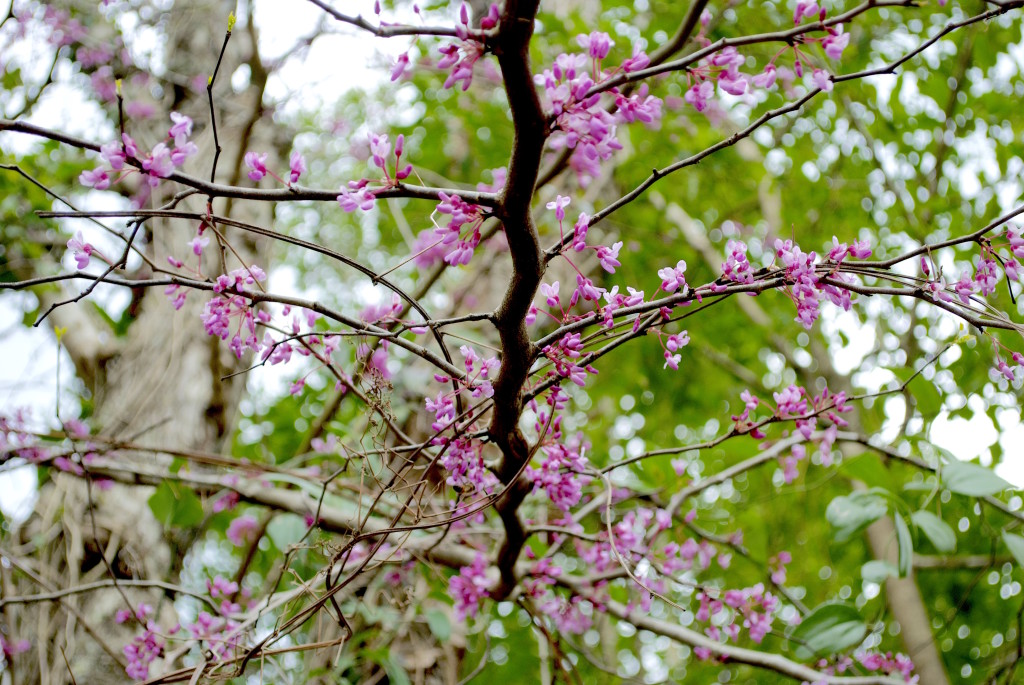
Among the many identifying characteristic of the Eastern Redbud is that its branches bend slightly at every node. Photo by Green Deane
There’s a common sight locally this time of year: Trees with no leaves covered with either small pink blossoms or white blossoms. First the pink.
The Eastern Redbud, Cercis canadensis, puts on a colorful show of pink blossoms every spring. If the blossoms are pink why is it called a Redbud? Because the buds are red but they produce pink flowers. The flowers, young heart-shaped leaves, and young pea pods are edible. The Redbud is both a native understory tree and planted in landscaping. Its blossoms have the classic petal arrangement of wings and keels, so typical of the Pea Family. It’s important to note the blossoms are small, half-inch to an inch or so. That has to be mentioned because there is an ornamental tree — Tabebuia heterophylla — also planted locally that has pink blossoms and no usually leaves in the spring. But those blossoms are big, 2.5 to 3.5 inches long. Also called the Pink Trumpet Tree it is very showy whereas the Redbud is modest. To read more about the Redbud go here.
Trees with white blossoms this time of year, and no leaves, tend to be plums among them the Chickasaw Plum and the Flatwood Plum. Of the two we want to find the Chickasaw Plum once it leaves out and starts to fruit. There is also an American Plum but ones does not come across that species too often here. I planted a Chickasaw Plums in my yard and within a few years had a large thicket of them, all producing. Like Mulberries, they love to grow and they taste good, too. It’s easy to tell the Chickasaw Plum once it leaves out so some patience is required. To learn how to identify the Chickasaw Plum click here.
I have a dear friend who is what we would call an English Garden gardener. He doesn’t grow plants for food. Plants are colors and textures with which he paints and sculpts his yard. It helps to know what the gardener, or the creator of a park, has or had in mind. In some parks toxic plants are preferred, Oleanders for example, but food-bearing plants are not. That’s because lawyers advising governmental agencies are afraid someone will eat some fruit or nut and get sick. Yeah, it’s irrational that toxic plants are okay and edible ones are not but that’s reality. It is one of the problems of letting the legal mindset dictate social values when there are other valid ways of thinking, such as historical or moral. It would seem reasonable to me that we practice the opposite in public parks, select food-bearing plants and phase out the toxic. Thus when I see a strange tree (or herbaceous plant) in a park my first thought is “toxic or edible?” I have a hard time thinking of a true gardener planting a toxic tree in a public park. An English Garden gardener might but not a food gardener.
So I had no idea what this tree was when I saw it in a public park in Winter Park. I was wondering who won, the lawyer or the gardener. It has a bit of an exotic look to it, and the striping on the fruit was strange as well. It looked like something that came from far away, maybe the other side of the world. Fortunately someone on a facebook page knew what it was. It’s a Fortunella margarita, which is a self-creating limequat. It came from a small twig seen on a 21-year-old Nagami Kumquat in Leesburg FL in 1986. For the record that is 59 miles away, not the other side of the earth (though Kumquats are from Southeast Asia.) The variegated mutation was spontaneous. You can read more about it here.
Foraging Classes: Saturday March 7th, Wekiva State Park, 1800 Wekiwa Circle, Apopka, Florida 32712. 9 a.m. Meet at the Sand Lake Parking Lot. Sunday, March 8th, John Chestnut State Park: 2200 East Lake Road, Palm Harbor, FL 34685, 9 a.m. Saturday, March 21st Wickham Park: 2500 Parkway Drive, Melbourne, FL 32935-2335., 9.a.m. Sunday March 22nd, Dreher Park, 1200 Southern Blvd., West Palm Beach, 33405. 9 a.m. Sunday, April 5th, Bayshore Live Oak Park, 23000 Bayshore Rd., Port Charlotte, FL 33980, 9 a.m. For more information or to sign up for a class go here.
Foraging seasons don’t end abruptly unless there is a sudden hard freeze or the like. I can still find chickweed but most of it has blossomed and is in the process of seeding. Pellitory is getting old and tough, kind of like this writer. Sow thistles are blossoming as well along with sorrel. Spring isn’t here yet but it is close. Our last average frost date is Valentine’s Day. We should have another bout of cold weather during the first full week in March, the next full moon, and from then on the weather should, for the most part, get warmer. Yesterday was a bit too warm at 81 F. This however, encourages that which must happen, such as the blossoming of the Mulberries. Interestingly while the amount of spring time rain can affect fruit and nut production there is a more significant indicator of yield. It is can the bees fly on the critical days the plants need pollinating. To read about Mulberries, go here.
The sold-out Florida Herbal Conference starts in three days however you can check for any cancellations. I’ve taught edible plants there for the last three years and will be there again this year. It’s a must for all southern herbalists and well as those northern ones who want to escape freezing cold and study their craft in the dead of winter. It always has interesting speakers and great classes. While there is some cross over between Earthskills and Herbalism the conferences are sufficiently different to justify attending both. I get the early morning specials Saturday and Sunday, 7 and 9 a.m. See you bright and early. And unlike previous years, the forecast is to be moderately warm but perhaps a little windy.
In nearly every class and daily on-line I am asked if I can identify a plant if a picture is sent to me. I say I will try and also suggest the sender join the Green Deane Forum. There’s a UFO page there, Unidentified Flowering Objects. On the forum we chat about foraging — and other topics — every day along with techniques to harvest and use the bounty you have found. And it’s not just about Florida or the southeast. There are members from all around North America and the world. The link to join is on this page just to the right of this article. Recent topics include What Do You See #17, Natural Eater Website, Looking Forward To Maple Bloom Tea, Dragon Pearls, Free Movie of Medicinal Plants, Mexican Poppy, Hailing From Alabama, Golden Rod’s Edible? Fire Roll, Wahoo Bark, Eating Bitter Foods, Witches Butter, Braiding Natural Cordage, Smilax-Asparagus alternative, Loquats Pie and Grappa.
What do you see? There are at least three different edible species in this photo. The answer will be here next week, or you can read it on the Green Deane Forum.
If you would like to donate to Eat The Weeds please click here.

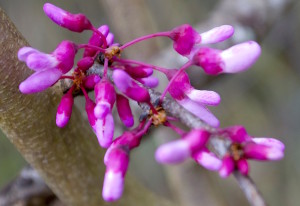
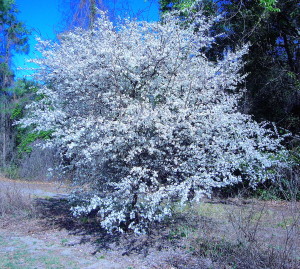
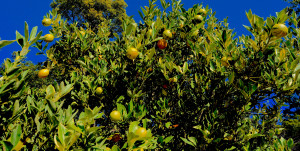
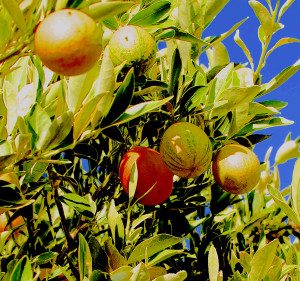
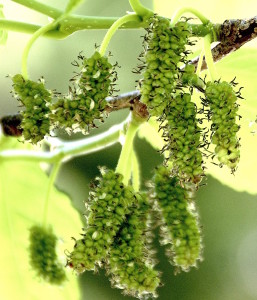
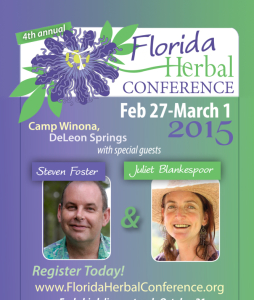

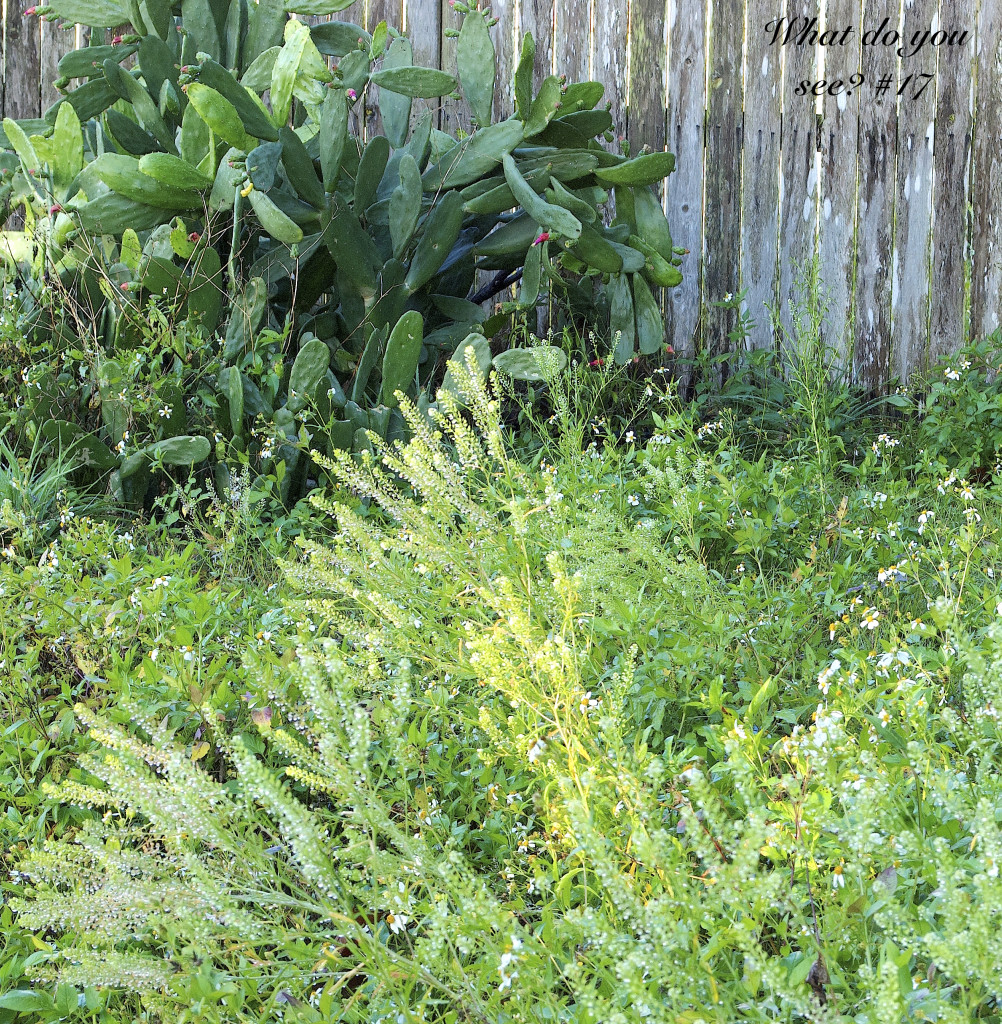

Deanne, What jumps out at me is the prolific Poor Man’s Pepper, Spanish Needle, and possibly some prickly pear in the back. Am I right? Guess I will find out next time.
I actually love to nibble on the fresh Poor Man’s Pepper this time of the year. I share it with students and friends who end up liking it too.
Yes, but it is not Prickly Pear but Nopales. Nopales used to be in the Opuntia genus but was farmed out into its own genus.
I have one of those variegated kumquats in my yard. The fruit are large and delicious. Truly a beautiful tree.
As for #17, I spot a Nopale cactus (horrible glochids but tasty young pads), Bidens alba (good stir-fried), Poor Man’s Peppergrass (zippy and good for sprinkling on deviled eggs), and maybe a Lariope “grass” in the back.
I’ve read those have edible roots but haven’t been hungry enough to try them.
Peppergrass, opuntia, shepherds needle
Pepper grass, Nopales, Spanish Needles…
The limequat margarita, locally named “Burtugal yabani(= Japanese orange) has been quite recently introduced into Sudan. I was also wondering who won:the gardener or the lawyer. Howver, I’m sure it isure it is the same mechanism which has sent Adam and Eve – peace upon them – out of Aden will prevail.
About trees without leaves I may sight the Winter thorn ( Apple – ring acacia or Acacia albida – or Faidherbia albida ) here locally called “Huraz tree” . It sheds its leaves during the rainy season ; but these mature during the dry season. Flower buds appear immediately after the qrowth of the leaves. The flowers are pale cream and look much beautiful. The tree is useful during fodder rarity and its fruit services as famine food during draughts. It is considered an ideal agroforestry species. Under our arid and semi – arid climatic conditions , it grows well among field crops without preventing sunlight during the rainy season and provides shade particularly for shepherds during draught periods. ( http:// http://www.feedipedia.org/node/357 )
A sudanese proverb ” What is between me and you is same as between Huraz tree and rain,” expresses dislike between opponents , based on the false assumption that the plant hates rain.
I want that yard! I love using all those plants, favorites! I use the nopales often in my fermented salsa, awesome! I got a load of eggplants a while back and grated them into the mix too…what serendipity…not only do they work just fine to bulk it up and add flavor, but between them and the nopales, it kept the tomatoes, peppers, cilantro, onions and garlic from getting soupy and made a really nice thick salsa! Bake me some crispy tortilla wraps and a little home-made un-cow yogurt on and we have a party!
Bidens alba, what’s not to love? Pretty flowers and tasty greens! I keep a nice patch hidden under my overgrown dwarf date palms all summer, and just pick the flowers for a mini arrangement to keep the beggars ticks from sticking to everything that passes, and keeps the new green growth coming. They make me happy! 🙂
And pepper grass! I love to take the green seeds and leaves and add them to a vegetable smoothie, (and some bidens and nopales too)…adds a great kick!